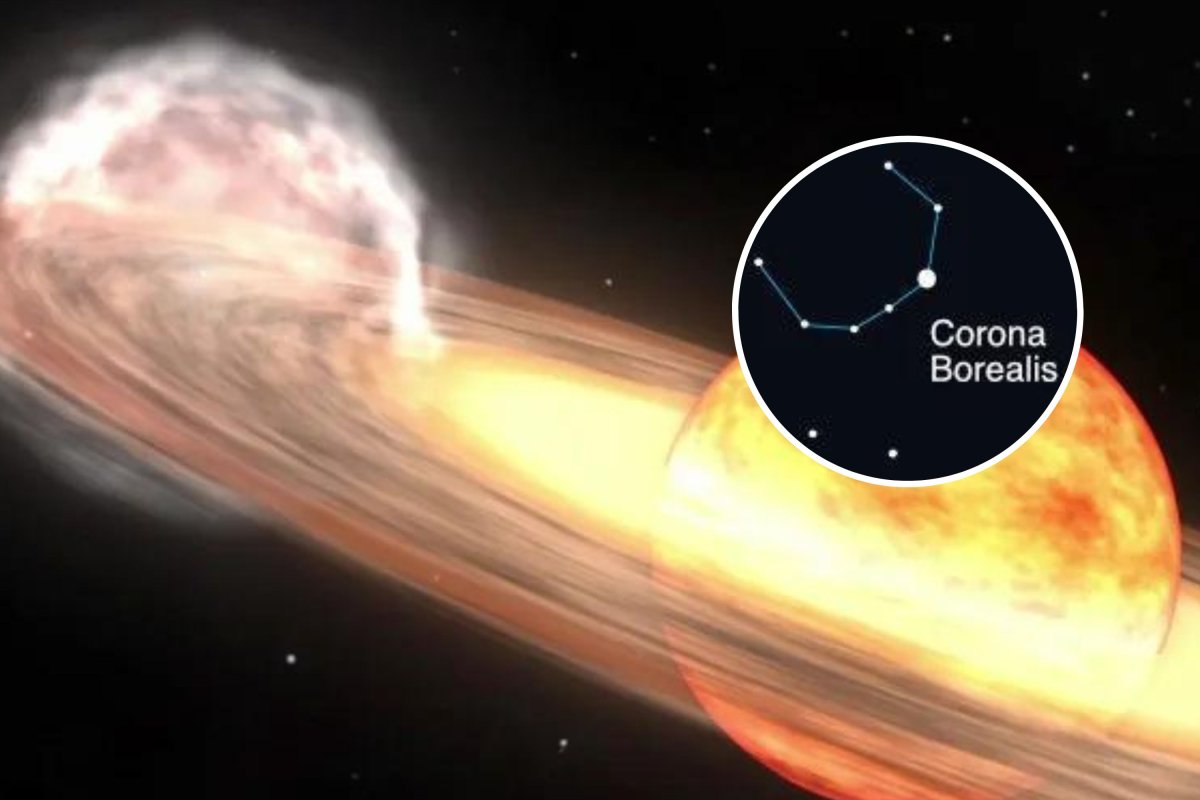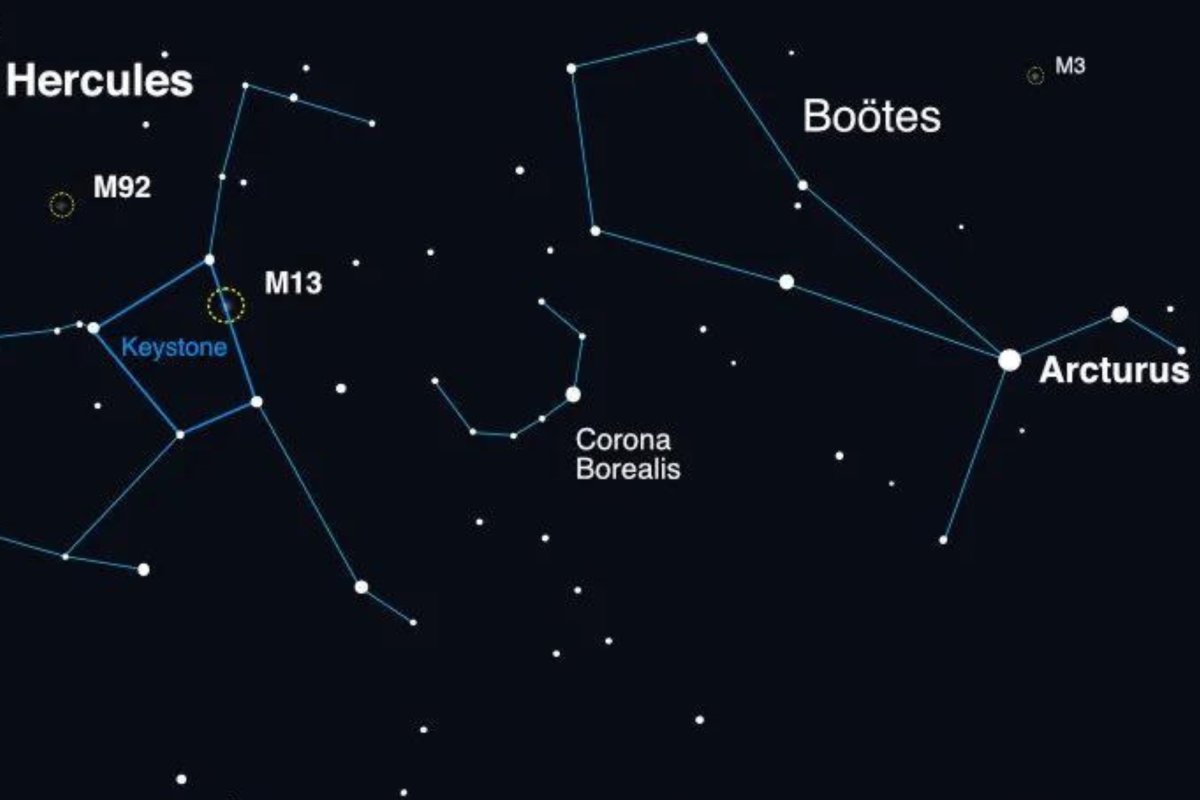The night sky may be on the verge of gaining a brand new star in a few weeks.
T Coronae Borealis, also known as “The Blazing Star” or T CrB, is a binary star system located about 3,000 light-years from Earth. It will explode in spectacular fashion any day now.
Usually too faint to see with the naked eye, T CrB is expected to outshine the North Star Polaris temporarily during its explosion, known as a “nova.”

NASA/Goddard Space Flight Center
T CrB is one of only five known recurrent novae in our galaxy. It consists of a white dwarf and a red giant orbiting each other in a binary system, with the white dwarf undergoing a regular freak outburst every 80 years or so—the last of which was observed in 1946. Researchers have observed that the star’s recent behavior is remarkably similar to the period leading up to its last outburst, suggesting that another outburst is imminent before September of this year.
How to distinguish T CrB
To find T CrB, sky watchers must look toward the Northern Hemisphere summer sky. T CrB is located in the constellation Corona Borealis, a distinctive horseshoe-shaped star pattern located between the constellations Hercules and Boötes. To find it, draw a straight line between the two brightest stars in the northern hemisphere—Arcturus and Vega—and then look between them to find the arc-shaped Corona Borealis. You can pinpoint the reddish Arcturus by following the handle of the constellation Ursa Major.
The eruption, once it occurs, will be visible for less than a week. Observers should look to the night sky just after sunset for the best chance of seeing the nova. The exact timing is unpredictable, but astronomers are confident the event will occur by September 2024. Hopeful stargazers will get the best view of the star away from light pollution.
Normally, T CrB has a magnitude of +10, making it invisible to the naked eye. Magnitudes in astronomy are measured backwards, with a lower number or higher negative number meaning an object is brighter—the full moon has a magnitude of -13, while the stars Sirius and Arcturus have magnitudes of -1.5 and -0.05, respectively. If an object has a magnitude of +6 or less, it will be visible to the naked eye. T CrB is expected to reach a magnitude of about +2 at its brightest, shining as brightly as Polaris, the 48th brightest star in our skies.

NASA
“It’s a once-in-a-lifetime event that will create a lot of young astronomers out there, giving young people a cosmic event they can observe for themselves, ask their own questions and collect their own data,” Rebekah Hounsell , one. said in a NASA statement, assistant research scientist specializing in nova events at NASA’s Goddard Space Flight Center in Greenbelt, Maryland. “This will feed the next generation of scientists.”
T CrB goes nova every 80 or so years due to a strange property of the red-white dwarf giant binary system. The white dwarf, which is the remnant core of a star that has collapsed, slowly steals hydrogen gas from the red giant’s atmosphere, growing larger and hotter, until it eventually explodes in a thermonuclear explosion. known as nova. These novae are less powerful than supernovae, which completely destroy a star at the end of its life.
After this explosion, the process starts all over again. This is why T CrB erupts about once every 80 years. The star system is behaving in a very similar way to how it was just before the last explosion, making astronomers fairly certain that a nova will occur before September of this year.
“There are some recurring novae with very short cycles, but typically, we don’t often see a recurring outburst in a human lifetime, and rarely one so relatively close to our system,” Hounsell said. “It’s incredibly exciting to have this front row seat.”
Astronomers hope to study the upcoming nova in detail using a variety of telescopes around the globe, including NASA’s Fermi Gamma-ray Space Telescope and NASA’s James Webb Space Telescope.
“Typically, nova events are so faint and distant that it is difficult to clearly identify where the explosive energy is concentrated,” Elizabeth Hays, head of the Astroparticle Physics Laboratory at NASA Goddard, said in the statement. “This is going to be really close, with a lot of eyes on it, studying the different wavelengths, and hopefully it will give us clues to start unlocking the specific structure and processes involved. We’re looking forward to getting the full picture of what’s going on.”
However, there is a small chance that the nova won’t happen at all before September.
“Recurring novae are unpredictable and opposite,” Koji Mukai, an astrophysics researcher at NASA Goddard, said in the statement. “Just when you think there can’t be a reason why they follow a certain certain pattern, they do—and as soon as you start relying on them repeating the same pattern, they completely deviate from it. We’ll see how T CrB behaves.”
Do you have a tip for a science story that Newsweek should be covered? Have a question about novae? Tell us via science@newsweek.com.
Unusual knowledge
Newsweek is dedicated to challenging conventional wisdom and finding connections in search of common ground.
Newsweek is dedicated to challenging conventional wisdom and finding connections in search of common ground.
#onceinalifetime #nova #explosion #sky
Image Source : www.newsweek.com